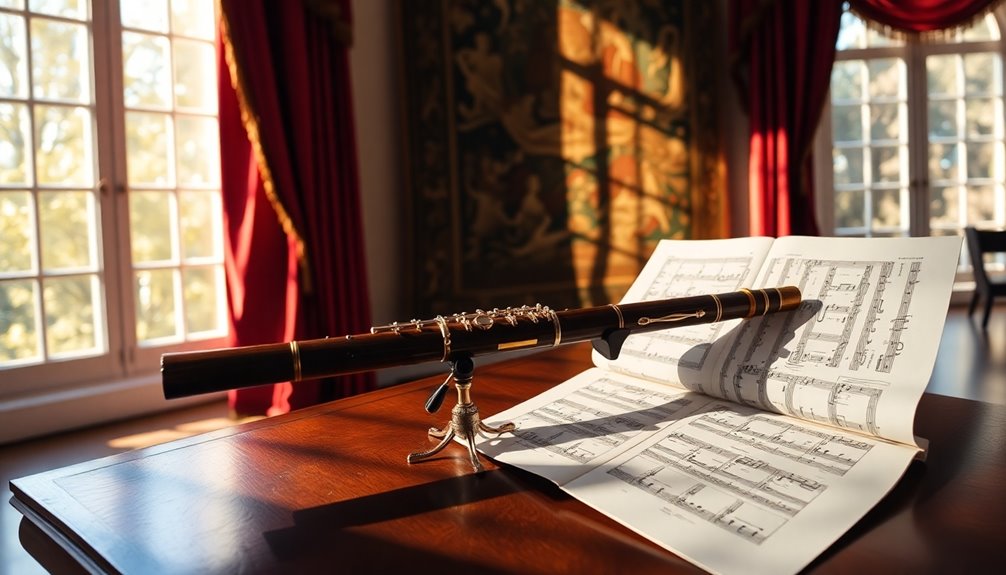Classical compositions today are vibrant tapestries woven from diverse musical styles. You'll notice how contemporary composers blend traditional folk elements, global rhythms, and jazz influences with classical structures. The flute, in particular, showcases versatility, adapting to various cultural expressions. You might find pieces that echo the intricate melodies of the Baroque or the emotional depth of the Romantic era, reimagined with modern techniques. This fusion invites you to experience rich storytelling through innovative soundscapes. If you're intrigued by how these elements intertwine, there's much more to uncover about this fascinating musical landscape.
Key Takeaways
- Contemporary compositions often blend classical flute with jazz, showcasing the instrument's versatility and cultural fusion.
- Works by composers like Tan Dun integrate world music elements, creating unique rhythmic patterns and tonal colors.
- Flute music incorporates folk traditions, using traditional melodies to bridge cultural heritage with modern compositions.
- The interplay between flute and percussion enhances dynamic dialogues, emphasizing rhythm's role in diverse musical styles.
- Celebrating shared musical heritage highlights the interconnectedness of global cultures through innovative classical works.
Baroque Flute Music

Baroque flute music, particularly from the late 17th to early 18th centuries, showcases the instrument's expressive capabilities through intricate melodies and dynamic contrasts. As you explore this era, you'll discover how composers employed Baroque techniques to enhance the flute's tonal qualities. The use of ornamentation, such as trills and appoggiaturas, allowed flutists to add personal flair, making each performance a unique experience.
Flute sonatas from this period are especially significant. Composers like Johann Sebastian Bach and Georg Philipp Telemann crafted sonatas that highlight the flute's agility and lyrical potential. You might find it fascinating how these pieces balance technical demands with emotional depth. They often feature alternating sections that contrast spirited allegros with introspective adagios, inviting you to explore a wide array of feelings.
Additionally, the interplay between the flute and continuo in these sonatas creates a rich texture. This collaborative aspect not only showcases the flute's role as a solo instrument but also emphasizes the importance of ensemble playing. By engaging with these works, you can truly appreciate how Baroque flute music fosters a sense of community among musicians and listeners alike.
As you immerse yourself in this music, you'll likely feel a connection to the past, experiencing the creativity and artistry of Baroque composers. The expressive techniques and engaging sonatas will resonate with you, drawing you into the vibrant world of Baroque flute music and its lasting impact on the musical landscape. This era laid the groundwork for future innovations in flute composition, including the emergence of extended techniques that further expanded the instrument's expressive range.
Romantic Era Influences

The Romantic era, spanning the 19th century, profoundly influenced the development of flute music, imbuing it with emotional depth and a broader expressive range. During this period, composers sought to convey intense feelings and personal experiences, leading to what we recognize today as romantic expression. This shift encouraged flutists to explore the instrument's full potential, moving beyond the technical mastery that characterized earlier styles.
As you listen to compositions from this era, you'll notice how composers like Franz Doppler and Gabriel Fauré utilized the flute to evoke a wide array of emotions. They crafted melodies that resonate deeply, allowing listeners to connect on a personal level. The music often reflects themes of nature, love, and longing, inviting you to experience a journey through each piece.
The Romantic era also saw the introduction of new techniques and tonal colors for the flute, enhancing its capacity for emotional expression. Composers incorporated virtuosic passages and lyrical phrases, encouraging flutists to showcase their interpretative skills. Additionally, the emotional depth of flute music fosters authentic artistic breakthroughs, allowing musicians to explore complex narratives and feelings.
This evolution not only enriched the repertoire but also fostered a sense of belonging among musicians and audiences alike, as they shared the universal language of emotion.
In essence, the Romantic influences on flute music created a vibrant landscape where emotional depth flourished. As you explore these works, you'll find that they not only celebrate the instrument's beauty but also reflect the very essence of human experience.
Contemporary Fusion Styles

Contemporary fusion styles emerge, creating a rich tapestry of sound that reflects diverse cultural backgrounds.
You'll notice how these styles thrive on genre blending, allowing artists to explore and expand their musical horizons. Through modern collaborations, musicians from various disciplines come together, breaking down barriers and inviting fresh perspectives.
Imagine a classical flutist collaborating with a jazz ensemble, where the airy tones of the flute intertwine with syncopated rhythms and improvisation. This interaction not only showcases the versatility of the instrument but also enriches the listener's experience.
The result is a music that feels both familiar and innovative, inviting you to connect with diverse traditions while embracing the new.
Contemporary fusion often draws on a wide array of influences, from world music to electronic sounds, creating pieces that resonate on multiple levels. For example, the fusion of flute and electronics opens new sound experimentation, creating captivating performances that engage audiences.
As you investigate deeper into this genre, you'll find that each composition tells a story, reflecting the unique cultural tapestry of its creators. The blending of styles invites you to experience music in a way that transcends conventional boundaries.
In this ever-evolving landscape, composers aren't just musicians; they're storytellers, weaving together threads of heritage and modernity.
Whether you're a casual listener or an avid enthusiast, contemporary fusion styles offer an inclusive space where everyone can find a connection, making you feel at home in the vast world of music.
Folk Elements in Compositions

Many contemporary composers are increasingly drawing inspiration from folk traditions, infusing their works with elements that resonate deeply with cultural heritage. By incorporating traditional melodies and motifs, they create a bridge between the past and present, allowing listeners to connect with their roots. This fusion not only celebrates diversity but also enhances cultural storytelling, as each piece tells a story reflective of its origins.
In exploring folk elements, composers often utilize specific techniques, as highlighted in the table below:
| Technique | Description |
|---|---|
| Use of Traditional Melodies | Integrating recognizable folk tunes into compositions |
| Storytelling through Music | Creating narratives that reflect cultural tales |
| Instrumentation | Employing folk instruments to enhance authenticity |
| Rhythmic Patterns | Adapting traditional rhythms for modern contexts |
| Modal Harmonies | Utilizing scales common in folk music for depth |
These techniques not only enrich the musical landscape but also invite the audience into a shared experience. You might find yourself reminiscing about your own cultural background, as these compositions evoke a sense of belonging. When you listen to a piece that weaves in folk elements, you're not just hearing music; you're participating in a dialogue that spans generations. This connection reminds us of the importance of cultural heritage and how it can be celebrated through innovative classical compositions. Embracing folk elements in contemporary works allows you to appreciate the beauty of diversity while honoring the stories that shape our identities. Additionally, the incorporation of ornamentation techniques in these compositions adds richness and authenticity to the overall musical experience.
Global Rhythms and Flute

Building on the rich tapestry of folk influences, global rhythms have also found their way into contemporary classical music, with the flute serving as a versatile vessel for these diverse sounds. You might notice how composers incorporate world music elements, creating a fusion that resonates well beyond traditional boundaries. The flute, with its ethereal tone, adapts beautifully to various rhythmic patterns, allowing it to embody the essence of different cultures.
When you listen to pieces that blend global rhythms, you can hear the flute take on roles that range from a subtle whisper to a vibrant shout. This instrument can mimic the intricate beats of African drumming or the delicate nuances of Indian classical music, showcasing its adaptability. Take, for example, the works of composers like Tan Dun or Kaija Saariaho, who effectively weave these diverse influences into their compositions.
The interplay of the flute with percussion instruments emphasizes the driving force of rhythmic patterns, creating a dialogue that invites you into a world of sound. By exploring this fusion, you not only deepen your appreciation for classical music but also connect with the broader human experience. The flute's integral role in folk music showcases its ability to convey cultural storytelling while bridging diverse musical traditions.
As you engage with these compositions, you'll find that the flute transcends its traditional role, inviting you to celebrate the beauty of global rhythms. By embracing this diversity, you become part of a larger conversation, one that acknowledges the rich tapestry of our shared musical heritage.
Frequently Asked Questions
What Are the Benefits of Studying Diverse Music Styles?
Studying diverse music styles enriches your understanding of cultural appreciation and enhances creative expression.
By exploring different genres, you connect with various traditions and histories, fostering a deeper sense of belonging within a global community.
You'll discover unique rhythms and melodies that inspire your own artistic endeavors.
Engaging with diverse music not only broadens your musical palette but also cultivates empathy and respect for the myriad voices that shape our world.
How Can I Incorporate Diverse Styles Into My Own Compositions?
To incorporate diverse styles into your compositions, you'll want to immerse yourself in the exhilarating world of cross-cultural collaboration and genre experimentation.
Imagine blending the rhythms of African drumming with the elegance of European classical! Start by studying various genres, then experiment boldly, mixing unexpected elements.
Don't just stick to one sound; let your creativity run wild. Embrace the beauty of musical diversity, and you'll create pieces that resonate with everyone, making them feel connected.
Are There Any Famous Composers Known for Blending Styles?
Absolutely, you'll find several famous composers known for blending styles.
Think of Igor Stravinsky, whose works showcase cross cultural influences and genre experimentation. He masterfully combined elements of Russian folk music with modernist techniques.
Another example is Leonard Bernstein, who fused classical music with jazz rhythms, creating a unique sound that resonates with many.
Exploring these composers will inspire you to embrace diverse styles in your own compositions, fostering a sense of belonging in the music community.
What Instruments Are Commonly Used in Diverse Music Styles?
In the vibrant tapestry of music, traditional instruments weave together cultural influences, creating a rich soundscape.
You'll often encounter guitars, flutes, and drums that resonate with the heart of various traditions. Each instrument carries stories, echoing the unique heritage of its origin.
As you explore diverse music styles, you'll notice how these instruments blend to form harmonious connections, inviting you to experience a world where every note speaks a universal language of belonging.
How Has Technology Influenced the Fusion of Music Styles?
Technology's revolutionized how you experience music, particularly through digital collaborations.
You can now connect with artists worldwide, breaking down genre barriers and encouraging genre experimentation. With just a few clicks, you're able to blend sounds like never before, creating unique fusions that resonate with diverse audiences.
This accessibility not only fosters innovation but also cultivates a sense of belonging, as you share and appreciate the rich tapestry of musical styles emerging from these collaborations.
Conclusion
In exploring classical compositions that embrace diverse music styles, you'll discover a rich tapestry woven from Baroque intricacies to contemporary fusions. Each piece, like a vibrant mosaic, reflects the influence of folk traditions and global rhythms, enhancing the flute's expressive capabilities. This journey not only broadens your understanding of classical music but also invites you to appreciate the interconnectedness of cultures. So, immerse yourself in these compositions and let the melodies transport you across time and space.






